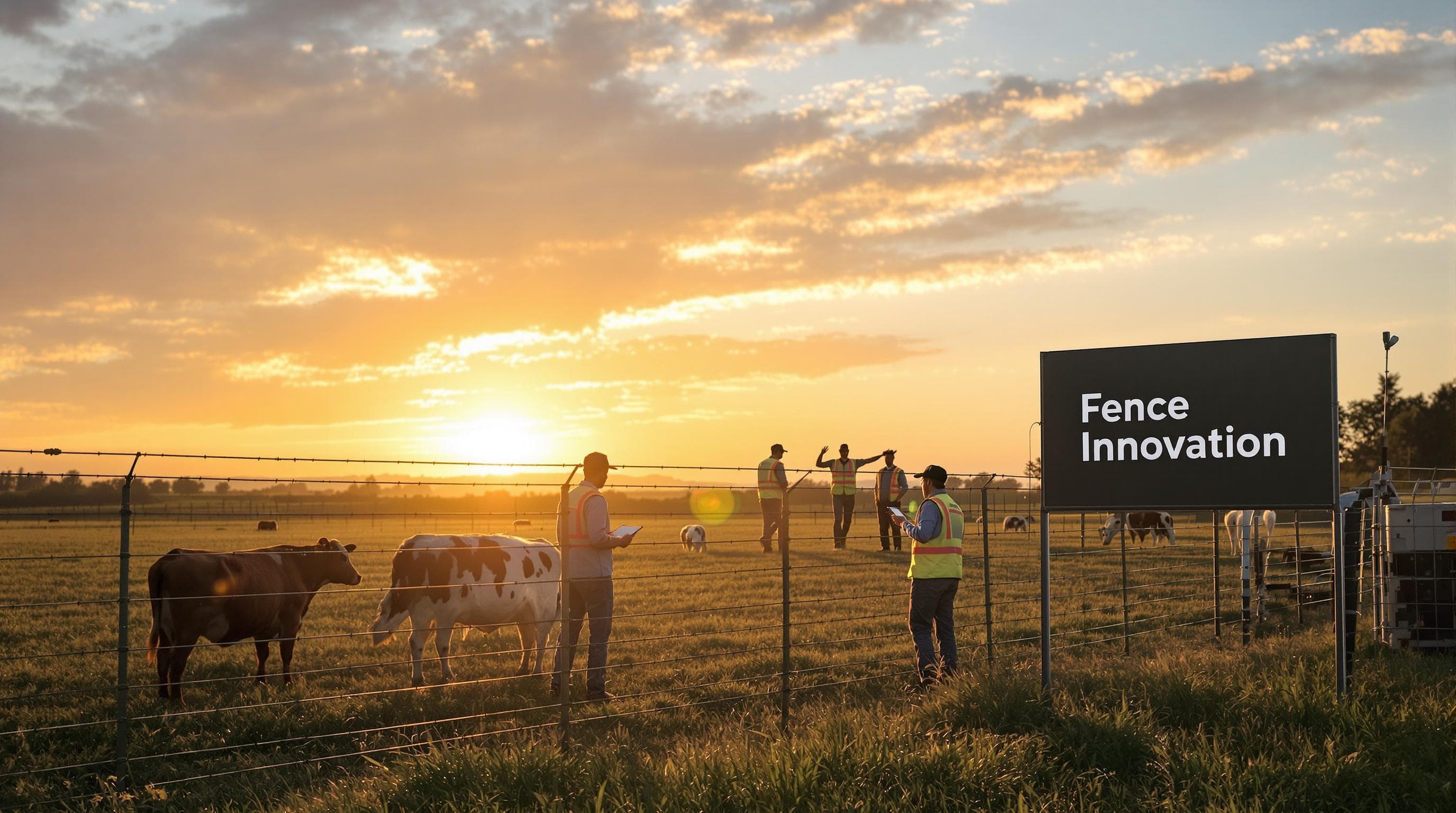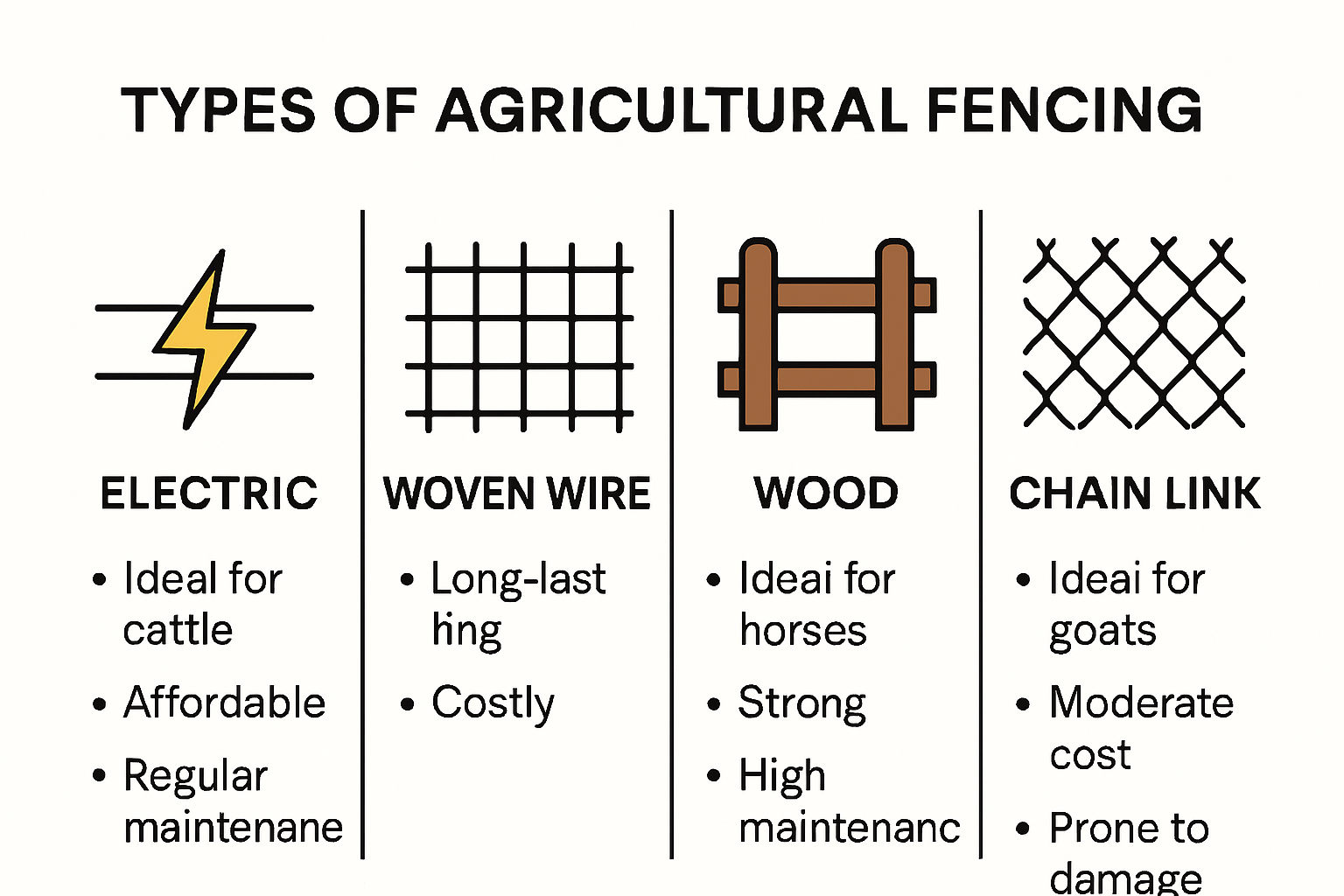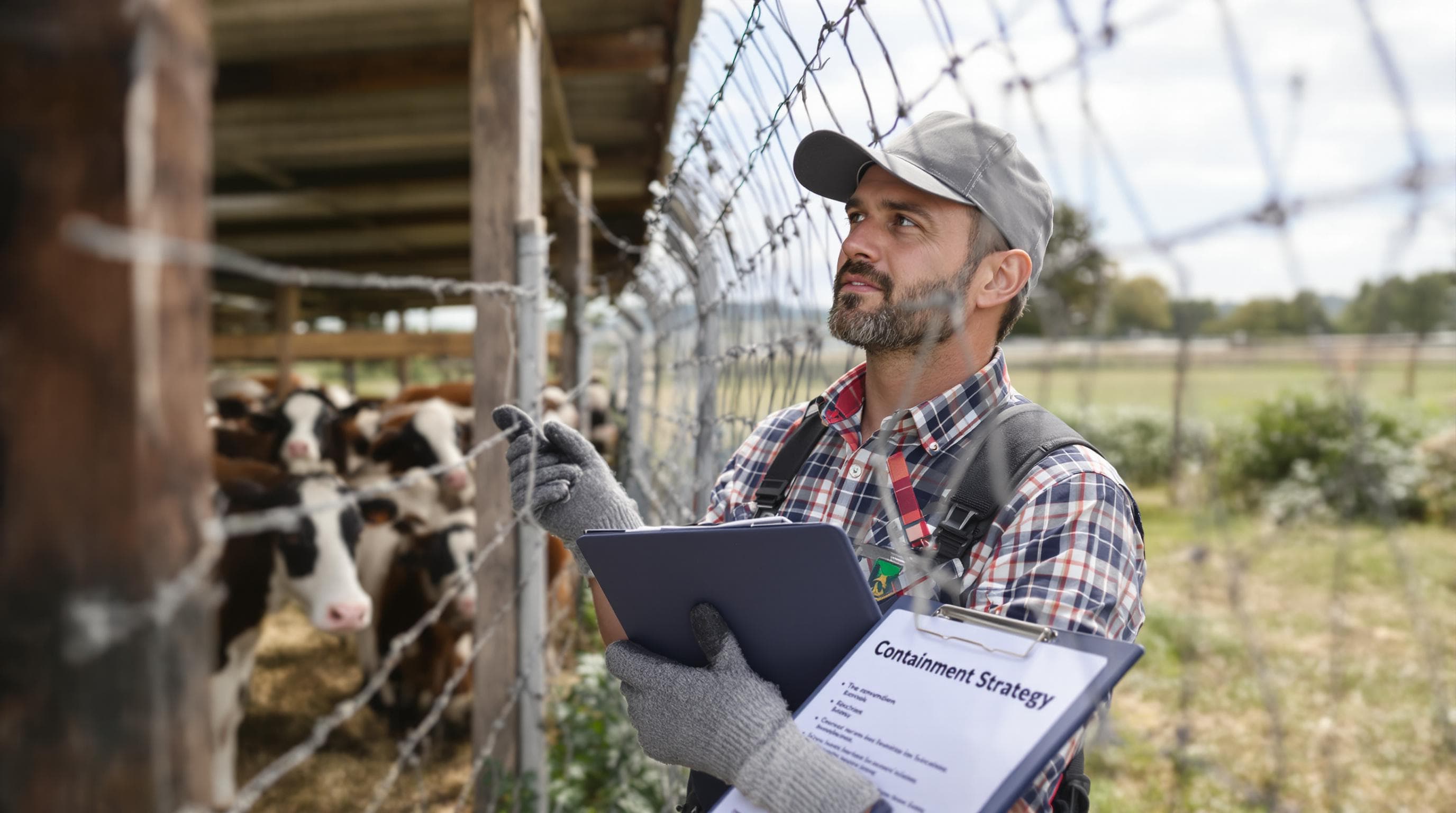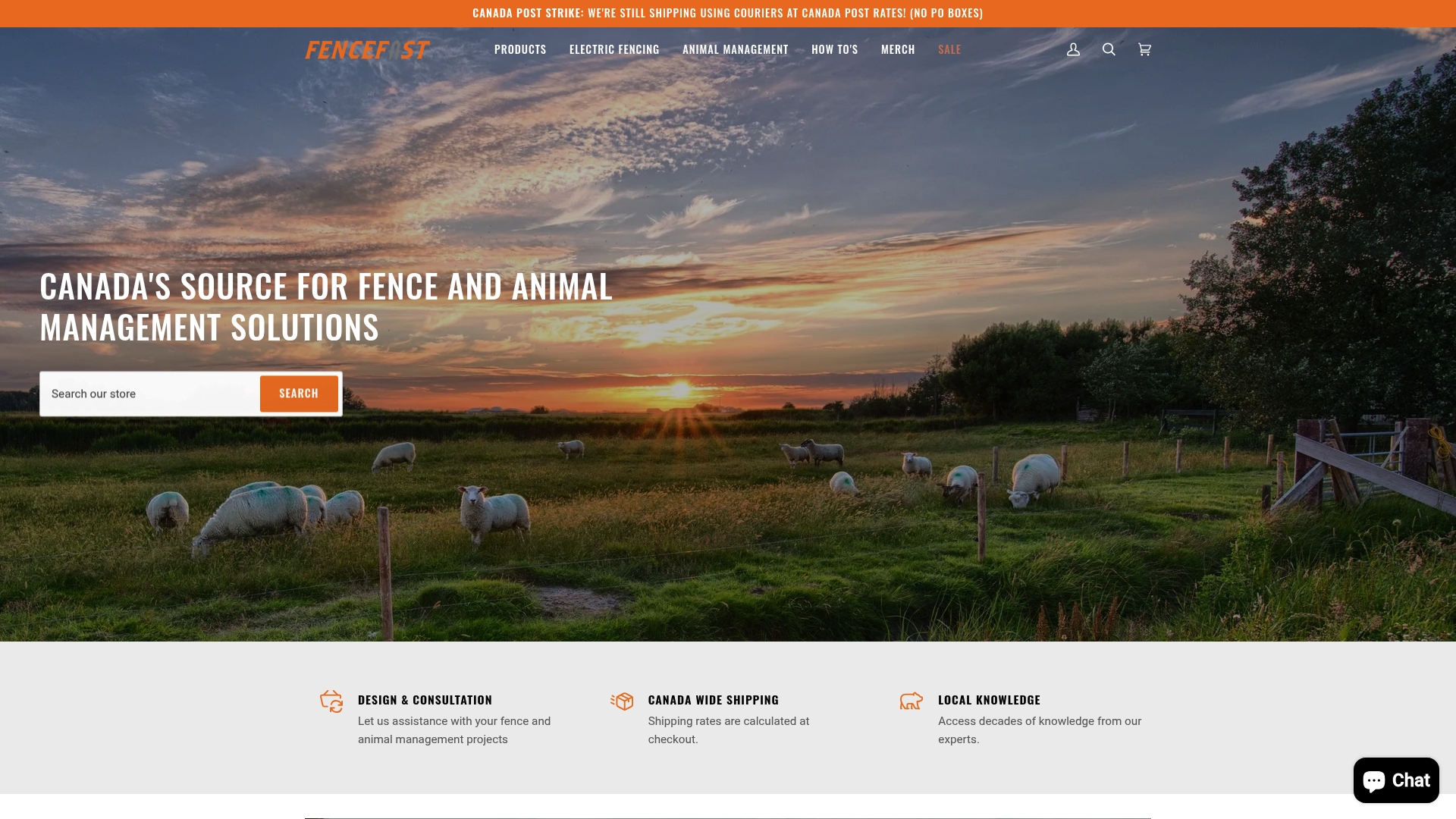
Picking the best agricultural fence in 2025 can make or break your farm’s efficiency. Farmers now have access to electric and non electric options, plus smart systems that can alert you of intrusions in real time. But what surprises many is that farmers using smart fencing options are reporting up to 30 percent fewer livestock escapes compared to traditional fences. The real challenge is not just choosing a material or style. It is learning which fencing strategy will actually save you money, protect your animals, and keep your land safe as new tech and trends reshape the future of farming.
Table of Contents
- Common Types Of Agricultural Fencing Explained
- Choosing The Right Fence For Your Needs
- Benefits And Maintenance Tips For Each Fence
- New Trends In Agricultural Fencing For 2025
Quick Summary
| Takeaway | Explanation |
|---|---|
| Evaluate livestock needs for fencing | Different animals require specific fencing types to ensure proper containment and management. Consider species behaviors before choosing a system. |
| Choose between permanent and temporary fencing | Permanent fences are ideal for long-term use, while temporary options offer flexibility for changing agricultural practices, such as rotational grazing. |
| Invest in high-quality materials | Selecting durable materials can reduce long-term maintenance costs and improve fence performance, ensuring effective livestock containment and property boundaries. |
| Maintain fence regularly | Regular maintenance of both physical and psychological fence barriers is essential to preserve functionality and protect livestock from escapes or intrusions. |
| Adopt sustainable fencing solutions | Explore eco-friendly materials and designs that minimize environmental impact while providing effective agricultural management and adaptability to changing needs. |
Common Types of Agricultural Fencing Explained
Agricultural fencing serves critical functions beyond simple boundary marking. Farmers and ranchers rely on strategic fencing solutions to protect livestock, manage property boundaries, and control animal movement across diverse terrains and agricultural environments.

Defining Agricultural Fence Requirements
Before selecting a fencing type, agricultural professionals must consider multiple factors that impact fence performance. The University of Massachusetts Amherst highlights that successful agricultural fencing requires understanding specific livestock behaviors, terrain characteristics, and operational needs.
Key considerations include animal species, property size, budget constraints, and environmental conditions. Different livestock have unique containment requirements. Cattle might need robust wire fencing, while sheep demand tighter mesh designs to prevent escape. Terrain also plays a significant role in fence selection, with rocky or uneven landscapes demanding more flexible installation approaches.
Electric and Non Electric Fencing Options
Electric fencing represents a modern, adaptable solution for agricultural property management. According to the Food and Agriculture Organization, electric fences function as psychological barriers that train animals through mild electrical deterrence. These systems offer several advantages:
- Cost Effectiveness: Lower material and installation expenses compared to traditional fencing
- Flexibility: Easy to adjust and relocate based on changing agricultural needs
- Minimal Physical Obstruction: Thin wire designs that do not impede landscape views
Non electric fencing options remain equally important. Traditional designs like wood rail, woven wire, and chain link provide robust physical barriers. The British Columbia Agricultural Fencing Handbook emphasizes that material selection should prioritize durability, maintenance requirements, and specific agricultural context.

Specialized Fencing Considerations
Beyond basic containment, agricultural fencing addresses complex management challenges. Some specialized fencing types include predator exclusion barriers, rotational grazing systems, and wildlife management perimeters. Farmers must evaluate not just immediate containment needs but long term property protection strategies.
Material diversity plays a crucial role in fence performance. Steel, wood, synthetic polymers, and composite materials each offer unique advantages. Steel provides exceptional strength and longevity, while wood offers natural aesthetic integration. Synthetic options increasingly provide lightweight, corrosion resistant alternatives that reduce long term maintenance demands.
Successful agricultural fencing requires thoughtful planning, understanding of animal behavior, and alignment with specific operational requirements. By carefully evaluating terrain, livestock needs, and budget constraints, farmers can implement fencing solutions that enhance property management efficiency and animal welfare.
Choosing the Right Fence for Your Needs
Selecting the appropriate agricultural fence involves a complex decision making process that extends far beyond simple property demarcation. Farmers and ranchers must carefully evaluate multiple factors to ensure their fencing solution meets specific operational requirements and provides optimal livestock management.
Livestock and Terrain Considerations
The type of livestock plays a critical role in fence selection. According to Farm and Dairy, different animal species demand unique fencing approaches. Cattle require robust barriers that prevent wandering, while sheep need tighter mesh designs that prevent squeezing through small openings. Goats present unique challenges with their climbing and jumping abilities, necessitating even more specialized fencing strategies.
Terrain characteristics significantly influence fence design and material selection. Rocky landscapes might require deeper post installations and more flexible wire systems. Sloped or uneven ground demands careful engineering to maintain fence integrity and effectiveness. The University of Maine Extension recommends assessing ground conditions thoroughly before fence installation to prevent future structural complications.
Permanent versus Temporary Fencing Systems
To clarify the differences, the following table compares permanent and temporary fencing based on key features described in the article:
| Feature | Permanent Fencing | Temporary Fencing |
|---|---|---|
| Use Case | Long-term boundary & containment | Flexible/seasonal land management |
| Material Examples | High tensile wire, wood posts, steel panels | Portable electric systems, light posts |
| Flexibility | Low—fixed in place | High—easy to relocate & reconfigure |
| Durability | High—built for longevity | Moderate—intended for short-term/rotational use |
| Investment | Higher initial cost, lower per-use over time | Lower initial cost, may need frequent changes |
| Suitable For | Consistent pasture, property delineation | Rotational grazing, temporary control |
Agricultural professionals must distinguish between permanent and temporary fencing solutions. Permanent fences serve long term boundary and containment needs, typically constructed with durable materials like high tensile wire, wood posts, or steel panels. These structures provide consistent livestock management and property delineation.
Temporary fencing offers greater flexibility for rotational grazing, seasonal land management, and dynamic agricultural operations. Portable electric fence systems allow farmers to quickly reconfigure pasture boundaries, manage grazing patterns, and create temporary containment zones. The B.C. Agricultural Fencing Handbook emphasizes that temporary fencing can significantly enhance pasture productivity and animal health by enabling strategic grazing management.
Material Selection and Long Term Performance
The following table summarizes material choices for agricultural fencing, highlighting strengths and considerations mentioned in the article:
| Material | Strengths | Considerations |
|---|---|---|
| Steel | Exceptional strength, longevity | May require rust prevention, higher cost |
| Wood | Natural look, cost effective (smaller areas) | Prone to rot, weathering, insects |
| Synthetic/Composite | Lightweight, corrosion resistant, low maintenance | May be less strong, variable upfront cost |
Material choice directly impacts fence durability, maintenance requirements, and overall performance. Steel offers exceptional strength and longevity, particularly in high stress environments. Wood provides natural aesthetic integration and can be cost effective for smaller operations. Synthetic materials like polymer composites increasingly offer lightweight, corrosion resistant alternatives that reduce long term maintenance demands.
Budget considerations must balance initial installation costs with long term performance. While cheaper materials might seem attractive initially, they often require more frequent repairs and replacement. Investing in high quality fencing materials can provide substantial economic benefits through reduced maintenance expenses and improved livestock management.
Successful agricultural fencing requires a holistic approach that considers animal behavior, terrain challenges, operational flexibility, and long term economic sustainability. By carefully evaluating these complex factors, farmers can implement fencing solutions that enhance property management efficiency, animal welfare, and overall agricultural productivity.
Benefits and Maintenance Tips for Each Fence
Maintaining agricultural fencing requires strategic planning and understanding of different fence types. Proper maintenance ensures longevity, effectiveness, and optimal performance across various agricultural environments.
Physical versus Psychological Barrier Maintenance
According to the University of Massachusetts Amherst, agricultural fences can be categorized into physical and psychological barriers, each demanding unique maintenance approaches. Physical barriers like mesh wire and wooden rail fences require regular structural inspections and proactive repair strategies.
Physical barrier maintenance involves:
- Structural Integrity: Checking posts for rot, damage, or shifting
- Wire Tension: Ensuring consistent wire tightness and alignment
- Material Degradation: Monitoring wood for weathering and potential replacement
Psychological barriers, primarily electric fencing, need different maintenance considerations. Regular electrical system checks, grounding verification, and vegetation management around wire lines are critical for maintaining deterrent effectiveness.
Maintenance Strategies for Different Fence Types
The Food and Agriculture Organization highlights that different fencing materials demand specialized maintenance protocols. Wood fences require periodic treatment against moisture and insect damage. Steel and metal fences need rust prevention and protective coating applications.
Electric fencing systems demand more technical maintenance. Mississippi State University Extension Service recommends:
- Regular Voltage Testing: Checking electrical charge consistency
- Insulator Inspection: Verifying no cracks or damage
- Vegetation Control: Preventing short circuits from overgrown plants
Long Term Performance and Cost Considerations
Successful agricultural fencing maintenance balances immediate repair needs with long term investment strategies. Farmers should develop comprehensive maintenance schedules that account for environmental conditions, livestock pressure, and specific fence material characteristics.
Budget allocation for fence maintenance should consider:
- Preventative Maintenance: Regular inspections and minor repairs
- Replacement Planning: Budgeting for eventual full fence system updates
- Material Quality: Investing in higher quality materials that reduce long term maintenance costs
Effective fence maintenance is not just about preserving physical structures but also ensuring animal safety, property security, and operational efficiency. By understanding the unique requirements of different fence types and implementing systematic maintenance approaches, agricultural professionals can maximize their fencing investments and maintain optimal farm management practices.
New Trends in Agricultural Fencing for 2025
The agricultural fencing landscape is rapidly evolving, driven by technological advancements, sustainability concerns, and innovative approaches to farm management. As we move into 2025, farmers are experiencing a transformative shift in how they conceptualize and implement perimeter and livestock management solutions.
Technological Integration in Fencing Systems
Emergent technologies are revolutionizing agricultural fencing beyond traditional physical barriers. The Geofenced Unmanned Aerial Robotic Defender (GUARD) research demonstrates a groundbreaking approach to field monitoring and wildlife management. These autonomous systems combine computer vision with aerial surveillance, creating intelligent perimeter monitoring that goes far beyond conventional fencing capabilities.
Computer vision technologies are enabling more sophisticated surveillance strategies. Automated Crop Field Surveillance research highlights how modern agricultural fencing is transitioning from passive physical barriers to active monitoring systems. These advanced approaches can detect potential intrusions, track animal movements, and provide real time data about field conditions.
Smart Fencing and Cybersecurity Considerations
As agricultural technologies become more interconnected, cybersecurity emerges as a critical consideration in fencing design. The Cybersecurity in Agriculture research underscores the increasing vulnerability of technology integrated farm systems. Modern fencing solutions must now balance physical protection with digital security, incorporating encrypted communication channels and robust protection against potential technological breaches.
Smart fencing technologies are introducing features like:
- Automated Intrusion Detection: Real time alerts for unauthorized entry
- Livestock Tracking: GPS enabled monitoring of animal movements
- Environmental Condition Monitoring: Sensors tracking temperature, humidity, and terrain changes
Sustainable and Adaptive Fencing Solutions
Sustainability is driving significant innovations in agricultural fencing materials and design. Farmers are increasingly seeking eco friendly alternatives that reduce environmental impact while maintaining high performance standards. Recyclable synthetic materials, solar powered electric fencing, and modular designs that minimize resource consumption are becoming more prevalent.
Adaptive fencing systems are gaining traction, offering unprecedented flexibility for changing agricultural needs. These systems can be quickly reconfigured, expanded, or relocated with minimal infrastructure disruption. Lightweight, modular components made from advanced composite materials enable farmers to rapidly adjust their field management strategies.
The future of agricultural fencing extends far beyond simple boundary demarcation. By integrating advanced technologies, prioritizing sustainability, and developing more intelligent monitoring systems, farmers can create more efficient, secure, and responsive agricultural environments. Learn more about our innovative fencing solutions that are shaping the future of agricultural management.
As agricultural challenges become more complex, fencing solutions must evolve to meet increasingly sophisticated demands. The convergence of technology, sustainability, and intelligent design is transforming how farmers protect, manage, and optimize their agricultural resources.
Frequently Asked Questions
What are the most common types of agricultural fencing?
The most common types of agricultural fencing include electric fencing, woven wire, wood rail, chain link, and synthetic materials. Each type serves different purposes depending on the livestock and terrain.
How do I choose the right fencing for my livestock?
Choosing the right fencing involves considering the specific needs of your livestock, such as their size, behavior, and ability to escape, along with the terrain of your farm. Cattle may need robust wire, while sheep might require tighter mesh to prevent escape.
What is the difference between permanent and temporary fencing?
Permanent fencing is designed for long-term use and typically involves durable materials such as wood or metal. Temporary fencing, on the other hand, offers flexibility for managing changing agricultural needs and can be easily relocated, often using portable electric systems.
How can I maintain my agricultural fencing effectively?
Effective maintenance of agricultural fencing involves regular inspections for structural integrity, checking for damaged materials, and ensuring proper tension in wired fences. For electric fences, regular voltage testing and vegetation control around the wires are essential to maintain effectiveness.
Ready to Protect and Empower Your Farm in 2025?
Your search for the right agricultural fencing in 2025 does not have to feel uncertain. If you are worried about rising livestock escapes, struggling with complex terrain, or want advanced security that keeps up with today’s smart farming techniques, you are not alone. The latest trends and technology discussed in this article show that modern fencing is your key to improved animal safety, efficiency, and peace of mind. You want solutions that work with your land and livestock, from electric fencing to sustainable materials and even RFID monitoring.

Now is the time to take control of your property’s boundaries with farm-tested supplies that match your unique needs. Visit FenceFast.ca for a complete range of fencing systems, animal management tools, and expert design support. Our solutions help you keep up with technological change and meet your goals for productivity and security. Whether you want to upgrade to smart electric fencing or need the right accessories for specialized livestock, explore our full product catalog and connect with our knowledgeable team today. Act now and transform how you secure and manage your farm for the year ahead.
Recommended
-
[
PFN16100-1 – FenceFast Ltd.
-
[
Gallagher Turbo Wire 2.5mm – FenceFast Ltd.
-
[
Gripple Small Cable Cutter – FenceFast Ltd.
-
[
Polyrope/Braid to Energizer Connector – FenceFast Ltd.
](https://fencefast.ca/products/polyrope-braid-to-energizer-connector)
